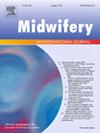Maternal health literacy and complementary medicine products: Information and recommendation sources used by pregnant and breastfeeding Australian women - results from a national online survey
IF 2.6
3区 医学
Q1 NURSING
引用次数: 0
Abstract
Background
Pregnant and breastfeeding women commonly use complementary medicine products (CMPs) (dietary supplements/herbal medicines). Maternal health literacy highlights the importance of women seeking information to benefit their own and their children's health. However, little data on women's information-seeking behaviours regarding CMPs during pregnancy and lactation exists.
Objectives
Identify pregnant and breastfeeding women's CMP information and recommendation sources; determine their most trusted sources; and describe the influence of these sources on CMP use decisions during pregnancy and lactation.
Methods
This primary study utilised a national, online, cross-sectional survey conducted with pregnant and/or breastfeeding Australian women using CMPs. Purposeful and snowball recruitment were used. Screening questions ensured respondents were currently pregnant and/or breastfeeding, over 18, using CMPs, and living in Australia. Respondents reported on their use of CMP information and recommendation sources. Data were analysed using descriptive statistics and chi-square tests to compare differences between pregnant and breastfeeding cohorts.
Findings
810 women (354 pregnant, 456 breastfeeding) completed the survey; 93.3 % had adequate health literacy, 81.9 % were university educated, and 74.8 % had medium-high incomes. Almost all (99.6 %; n = 809) used dietary supplements; 57.3 % (n = 464) used herbal medicines. General practitioners (GPs) were the most trusted HCPs (27.0 %; n = 219). Significantly more breastfeeding women (p < 0.0001) trusted naturopaths, herbalists, GPs, pharmacists, child and family health nurses, and lactation consultants. Significantly more pregnant women (p < 0.0001) trusted midwives and obstetricians. Recommendations from HCPs positively influenced CMP use, while recommendations online or print media generally did not.
Conclusions
Pregnant and breastfeeding women seek information on CMPs from various sources but trust HCPs the most. Maternity care clinicians should consider the diverse information and recommendation sources women access when discussing CMP use.
孕产妇健康素养和补充药物产品:澳大利亚孕妇和哺乳妇女使用的信息和建议来源——全国在线调查的结果
背景孕妇和哺乳期妇女通常会使用辅助医药产品(CMPs)(膳食补充剂/草药)。孕产妇健康知识扫盲强调了妇女为自身及其子女的健康寻求信息的重要性。目标确定孕妇和哺乳期妇女的 CMP 信息和建议来源;确定她们最信任的来源;描述这些来源对孕期和哺乳期 CMP 使用决策的影响。采用了有目的的招募和滚雪球式招募。筛选问题确保受访者目前处于怀孕和/或哺乳期、年满 18 岁、使用 CMPs 并居住在澳大利亚。受访者报告了他们使用 CMP 的信息和建议来源。我们使用描述性统计和卡方检验对数据进行了分析,以比较孕妇和哺乳期妇女之间的差异。调查结果显示,810 名妇女(354 名孕妇,456 名哺乳期妇女)完成了调查;93.3% 的受访者具备足够的健康知识,81.9% 的受访者受过大学教育,74.8% 的受访者收入中等偏上。几乎所有人(99.6%;n = 809)都使用膳食补充剂;57.3%(n = 464)使用草药。全科医生(GP)是最值得信赖的保健医生(27.0%;n = 219)。信任自然疗法师、草药医生、全科医生、药剂师、儿童和家庭保健护士以及哺乳顾问的哺乳期妇女显著增多(p < 0.0001)。信任助产士和产科医生的孕妇显著增多(p < 0.0001)。保健医生的推荐会对 CMP 的使用产生积极影响,而网络或印刷媒体的推荐一般不会产生积极影响。在讨论 CMP 的使用时,产科护理临床医生应考虑到妇女获取信息和建议的不同来源。
本文章由计算机程序翻译,如有差异,请以英文原文为准。
求助全文
约1分钟内获得全文
求助全文
来源期刊

Midwifery
医学-护理
CiteScore
4.50
自引率
7.40%
发文量
221
审稿时长
13.4 weeks
期刊介绍:
Midwifery publishes the latest peer reviewed international research to inform the safety, quality, outcomes and experiences of pregnancy, birth and maternity care for childbearing women, their babies and families. The journal’s publications support midwives and maternity care providers to explore and develop their knowledge, skills and attitudes informed by best available evidence.
Midwifery provides an international, interdisciplinary forum for the publication, dissemination and discussion of advances in evidence, controversies and current research, and promotes continuing education through publication of systematic and other scholarly reviews and updates. Midwifery articles cover the cultural, clinical, psycho-social, sociological, epidemiological, education, managerial, workforce, organizational and technological areas of practice in preconception, maternal and infant care.
The journal welcomes the highest quality scholarly research that employs rigorous methodology. Midwifery is a leading international journal in midwifery and maternal health with a current impact factor of 1.861 (© Thomson Reuters Journal Citation Reports 2016) and employs a double-blind peer review process.
 求助内容:
求助内容: 应助结果提醒方式:
应助结果提醒方式:


